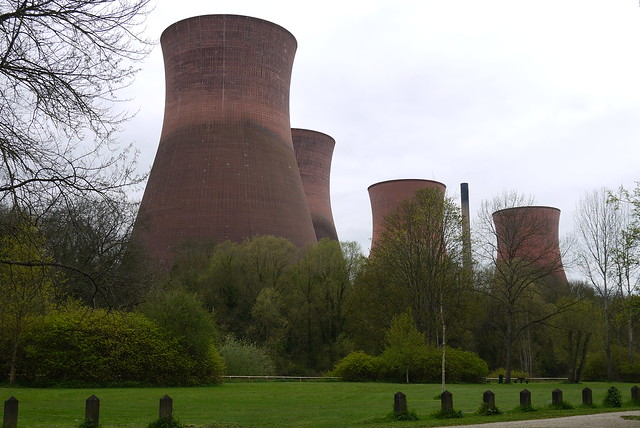![]()
This photograph depicts the cooling towers of Ironbrige B power station, which was designed to blend in with it’s surroundings:
Project architect Alan Clark worked closely with landscape architect Kenneth Booth, in order to ensure that the station merged as seamlessly as possible into its natural surroundings.[1] In this respect, the power station is unique amongst British coal-fired stations. When viewed from Ironbridge, the surroundings of the station are hidden by wooded hills. The cooling towers were deliberately constructed using concrete to which a red pigment had been added, to blend with the colour of the local soil. This had cost £11,000 in the 1960s. The towers cannot be seen at all from the world famous landmark, The Iron Bridge. The station’s single 205 m (673 ft) high chimney is fifth tallest chimney in the UK. It is the tallest structure in Shropshire, as well as being taller than Blackpool Tower and London’s BT Tower.[5]
The station’s turbine hall is decoratively clad in chipped granite faced concrete panels, aluminium sheeting, and glazing. The turbine hall obscures the rather more functional metal clad boiler house from view. A free-standing administration block continues the theme of concrete panelling, albeit with extensive use of large floor to ceiling windows.[1] Period fittings within the administration block include a board room, containing murals that reference the industries of the Ironbridge Gorge, and a grand entrance hall with a metallic mural.
So impressive were the measures taken to ensure that the power station was an asset to the gorge and not an eyesore, that it was short listed for a Royal Institution of Chartered Surveyors/The Times conservation award in 1973.[1]
Click here for a photograph that I took a few years ago that shows the complete power station from the other direction. I will let you judge for yourselves whether or not the architect achieved his aim in merging the structure into the surrounding landscape.









I think failed. Still they look impressive looming out of the trees as they do
I do wonder how they got planning permission to build it there…
I remember seeing cooling towers along the English countryside when Penny and i took the train from Glasgow to London years ago Cherie… they stand out very much around farmland… but i guess they are a necessity….peter:)
The power is a necessity but I jut wonder about the best places to build the structures…
I think they did their best. It’s not really obnoxious, once we know their raison d’être.
From the cooling tower side, it is quite aesthetically pleasing but when you move around the other side it looks quite hideous in my opinion!
Have you been to Ilfracombe, C?
These towers remind me of their famous theatre!
Yes… but it was a long time ago and I don’t remember the theatre!!
I am tempted to ask, what cooling towers as they have blended in so well with their surroundings? Standing out like four sore thumbs…
From this side they aren’t too unpleasant but they do spoil the countryside. I have always wondered how they got planning permission to build them there next to a world heritage site…
I thought I recognised those cooling towers !
Wean from Shropshire
They are rather distinctive aren’t they?
I was going to comment but you said it for me:
I will let you judge for yourselves whether or not the architect achieved his aim in merging the structure into the surrounding landscape.
Well what do you think? Did he acheive his aim?